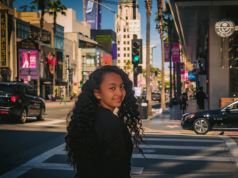One can only marvel at the flowetry in motion called the art of modern dance.
The shear fortitude needed to become capable of such stunning physical fetes, can only spill from a soul filled with courage, strength, resolution, determination, grit, patience, endurance, backbone, perseverance, staying power, and strength of mind. You only have to see the brilliant talent of Annique S. Roberts in action, to know that she not only possesses these attributes in spades—but has indeed, mastered them with grace.
Annique is a native of Atlanta, Georgia and graduate of Tri-Cities High School for the Visual and Performing Arts. She was a student at the Alvin Ailey School’s Junior Division and at the Jacob’s Pillow Dance Festival. She graduated magna cum laude with a BFA in Dance from Howard University, and in 2011 was awarded the James Butcher Distinguished Alumni Award from her alma mater. Annique danced with Garth Fagan Dance before going on to instruct there for over five years. She has been featured in Dance Magazine (2008), and TimeOut-NewYork. Most recently, Annique was nominated for a 2013 New York Dance & Performance (Bessie) Award for Best Performer—the highest achievement in the dance industry.
Now based in New York, Annique is currently dancing with Ronald K. Brown-Evidence, serving as Assistant Rehearsal Director, and is currently finishing her master’s degree in arts administration at Savannah College of Art. Adding to the list of her core competencies, Annique is a certified Pilates instructor and group fitness trainer. A true treasure on the stage as well as off, Annique is a passionate and active fund raising advocate for the Arts in Georgia.
Arts Advocacy
By: Annique Roberts
In March of this year, Americans for the Arts hosted their 29th Arts Advocacy Day, where representatives of the arts and culture industry from across the nation gathered in Washington, DC. Arts administrators, entrepreneurs, and activists took to Capitol Hill to lobby Congress for an increase in arts funding and support for a broad range of legislative initiatives, including increasing funding for the National Endowment for the Arts and the Assistance for Arts Education bill. I joined a group of my colleagues from Savannah College of Art and Design’s Student Arts Managers club to participate. Since I live in New York City where the arts are relatively well-supported and represented in government (NYC’s representatives serve on and co-chair the Congressional arts and STEAM caucuses and serve on the Senate Cultural Caucus), I chose to lobby for my home state of Georgia, which comes almost dead last in government spending in the arts.
I walked into Congressman Austin Scott’s office and noticed deer heads and turkey feathers adorning his office walls. I had entered unfamiliar territory and wondered how do I position my argument to convince this very conservative staff to support increasing government spending on the arts and arts education. Congress was in recess so we met with a staff member, whom my team leader researched to find some common ground. Bingo! She and my team leader both attended Northeastern University. That was our way in. Her ears perked up, her torso leaned forward, and we had her attention. Now we could make our pitch.
But why is a pitch even necessary? The research is there. The socioeconomic impact of the arts is well-documented. Seemingly, making the argument for the vital role the arts play in society and the need for government support is like making the argument for climate change. The evidence is undeniable, yet there is still debate about its existence and the importance of making it a priority.
 According to an analysis by American’s for the Arts, the arts and culture sector contributes 4.32% or $700 billion to the gross domestic product. That is more than agriculture and tourism combined and more than 45 states! The arts and culture industry supports 4.1 million jobs. With these facts, the NEA’s ask for an increase of funding from $148 million to $155 million seems conservative, especially considering that appropriations for the NEA has failed to keep up with inflation. If funding levels stayed the same, the NEA should be receiving $301 million—not pleading for a dismal $155 million. And even with the meager crumbs Congress musters for the NEA, for each dollar spent another six to seven dollars is spent from other resources. Show me another line item in Congress’ budget that gets such a return on investment.
According to an analysis by American’s for the Arts, the arts and culture sector contributes 4.32% or $700 billion to the gross domestic product. That is more than agriculture and tourism combined and more than 45 states! The arts and culture industry supports 4.1 million jobs. With these facts, the NEA’s ask for an increase of funding from $148 million to $155 million seems conservative, especially considering that appropriations for the NEA has failed to keep up with inflation. If funding levels stayed the same, the NEA should be receiving $301 million—not pleading for a dismal $155 million. And even with the meager crumbs Congress musters for the NEA, for each dollar spent another six to seven dollars is spent from other resources. Show me another line item in Congress’ budget that gets such a return on investment.
But we in the arts are dreadfully and paradoxically accustomed to doing a lot with very little. In our industry it is normal to work for free, and often times expected. Non-profit is synonymous with no profit and making a profit equals selling out. So, perhaps our business plan is a little flawed or outdated. But the fact remains, non-profit arts organizations rely on contributed revenue and our government sets the tone. When Congress says the arts matter, other funding sources fall in line.
We can’t forget just how much the arts matter and how they populate our daily lives. Some may think the arts are just a hobby to kill time and entertain. Maybe that’s because there is no standardized test for proficiency. But the real test is much larger and more consequential. Stripping away the arts results in a drab and stagnant world where creativity lies dormant. The good news is that it can be awakened and summoned by exposure and access, which is amplified by government support.
For those who may quickly dismiss my message and think surely we can survive without the arts, I encourage you to try and live one day untouched by art. Technology would be like a re-run of the fifties were it not for design and innovation. Without art you can say goodbye to television, movies, music, theatre, opera, dance, magazines, and books. Advertising without creativity would be nothing more than a “For Sale” sign. Tourism would die. Could you imagine New York City without Broadway, the museums, skyscrapers, Times Square, the Statue of Liberty, and the Brooklyn Bridge? Imagine a world without the yoyo, YoYo Ma, or Yo Mamma jokes. Creativity drives innovation and innovation is the foundation of our new economy. Is a world without the arts one in which you want to live? Defunding the arts would move us closer to that dreadful place. For more information Annique can be contacted at anniquesherelle@gmail.com












